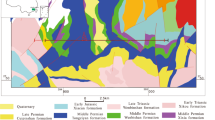Abstract
Taking the Qihe area as an example, this paper compared various geophysical exploration methods in view of the problems of urban construction, deep thermal reservoir burial, and vast overlying low-resistance shield layer in deep karst geothermal exploration. A Controlled-source audio magnetotelluric (CSAMT) method was taken to overcome the problems and detect deep stratigraphic structures in the study area. The acquisition parameters of CSAMT were optimized to take into account the exploration depth and signal-to-noise ratio. The distortion of data in the near and transition zone was eliminated by the inversion of equivalent whole-region apparent resistivity, so as to achieve the purpose of deep sounding. Based on the resistivity profile resulting from the proposed CSAMT method, three faults were inferred and one low-resistance anomaly zone in the area was traced. The results of the profile interpretation were verified by drilling. The inferred stratigraphic boundaries and low-resistance anomaly zone were basically in agreement with the drilling results, thereby proving the effectiveness of the CSAMT method for deep geothermal exploration in low-resistance coverage areas. This method could provide technical support for deep geothermal exploration in similar areas.
Similar content being viewed by others
Reference
Aykac S, Timur E, Sari C, et al., 2015, CSAMT investigations of the Caferbeyli (Manisa/Turkey) geothermal area: Journal of Earth System Science, 124(1):149–159.
Chen X, Li D C, Xu Z H, 2008, Application of seismic exploration technology in geothermal exploration: Geotechnical investigation and Surveying, 12:57–59.
Di Q Y, Zhu R X, Xue G Q, et al., 2019, New development of the electromagnetic (EM) methods for deep exploration: Chinese J. Geophys. (in Chinese), 62(6):2128–2138.
Gao J, Zhang H J, Zhang S Q, et al., 2018, Three-dimensionalmagnetotelluric imaging of the geothermal system beneath theGonghe basin, northeast Tibetan Plateau: Geothermics, 76: 15–25
Gong H, Ma R H, Duan J H, 2022, Elimination of Low Resistivity Shielding in TEM Data Interpretation: Coal Geology of China, 13(1): 19(S2): 126–127,134.
Huang L J, 2021, Application of controlled source audio-frequency magnetotelluric sounding method in exploration of low-medium temperature geothermal field: Chinese Journal of Engineering Geophysics, 18(3): 336–341
Kaufman A A, Hoekstra P. Electromagetic Soundings, 2001, Amsterdam,Netherlands: Elsevier Science.
Li H, Li T L, Wu L, et al., 2015, Transformation of all time apparent resistance of csamt and analysis of its effect: Progress in Ge plus physics (in Chinese), 30(2): 889–893.
Li S, Han T, Liu L J, et al., 2022, The deep electrical structure and thermal characteristics of the Zhangshuningdemagnetotelluric profile in South China: Chinese J. Geophys. (in Chinese), 65(4): 1354–1375.
Luan X. D., Di Q. Y., Lei D, 2018, Near field correction of CSAMT data based on Newton iteration method and Ga method: Chinese J. Geophys.(in Chinese), 61(10):4148–4159.
Streich R, 2016,Controlled-Source Electromagnetic Approaches for Hydrocarbon Exploration and Monitoring on Land: Surveys in Geophysics, 37(1):47–80.
Sui S Q, Wang X W, Zhou Z Y, et al., 2019, Study on the thermal reservoir characteristics of karst geothermal fields in Tianjing city:Geology and resources, 28(6):590–594,569.
Tang J T, He J S, 2005, Controlled Source Audio-frequency Magnetotellurics and Its Application: Changsha: Central SouthUniversity Press.
Yang F Q, Chen K, Long Y F, et al., 2022, Experimental study on deep electrical exploration in low resistance shielded area: Mineral Exploration, 13(01):61–73.
Younis A, El-Qady G, Alla M A, et al., 2015, AMT and CSAMT methods for hydrocarbon exploration at Nile Delta, Egypt:Arabian Journal of Geosciences, 8(4):1965–1975.
Yu Y P, Yan Z T, Mao X J, et al., 2021,The application of the comprehensive electric and seismic method to coal exploration in the huge Cenozoic coverage area: Geophysical and Geochemical Exploration, 45(5):1231–1238.
Zhang H, Sui S Q, Qian L R,et al.,2020, The application of multiple non-seismic methods to geothermal exploration in Qihe, Shandong Province: Geophysical and Geochemical Exploration, 44(4):727–733.
Author information
Authors and Affiliations
Corresponding author
Additional information
This research is supported by the National Natural Science Foundation of China (No 52174048).
The first author: Qiao Yong (1986–), since 2019 he has been studying for his Ph.D. at College of Geosciences, Yangtze University, Wuhan. His main research direction is geothermal exploration and development, geothermal policy research. E-mail: 89561564@qq.com.
Rights and permissions
About this article
Cite this article
Qiao, Y., Zhang, H. Methodology and Application of Deep Geothermal Sounding in Low-Resistance Cover Areas. Appl. Geophys. (2023). https://doi.org/10.1007/s11770-023-1026-y
Received:
Revised:
Published:
DOI: https://doi.org/10.1007/s11770-023-1026-y




